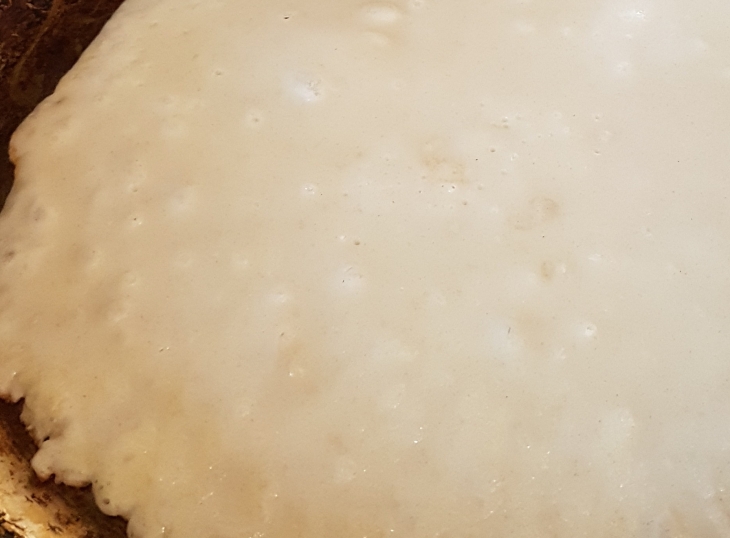Our recent interest in ice cream making has inspired me to finally get the hang of proper egg custard. It’s one of those slightly creepy kitchen transformations, like whipping cream by hand.
For ages you stand there stirring or whipping and nothing seems to be happening, then just as you’re about to give up the mix changes consistent entirely and becomes disconcertingly something else. At least the outcome in both cases is delicious.
Anyhow and anyhoo, making ice cream therefore demands a lot of egg yolks, and leaves over a lot of egg whites. That’s sent me scrambling for Things To Do With Egg Whites. The obvious course is meringue, but given the quantities of sugar and cream we’re piling into the ice cream I feel that introducing more crunchy sugar treats into the house is probably not good for anybody’s teeth, diet, or peace of mind.
Enter the egg-whites-only pancake.
Ingredients
- 150g flour
- pinch of salt
- 4 egg whites
- three tablespoons vegetable oil, plus extra for frying
- 400ml milk
Method
- If you intend to pile up the pancakes to serve together once they’re all done, turn the oven on to a low temperature (say 50 degrees) and put a plate in to warm up.
- Put the flour and the salt in a mixing jug. Make a dip in the middle and pour in the egg whites and vegetable oil. Mix.
- Add the milk slowly, stirring as you go to get a smooth batter.
- Put a frying pan on a high heat with a good quantity of oil. When a drop of water hisses and spits on the oil, the pan is hot enough. Pour off excess oil into a mug so that the pan has a thin, even covering.
- Pour batter into the pan and tip to spread it thinly. Batter made without yolks is a little paler than usual pancake batter, but will brown up similarly. If you find it’s sticking more than you expect, try stirring another teaspoon of oil into the batter.
- As the batter cooks, tiny dips should appear on the surface where bubbles have popped and the hole hasn’t closed up. When you see these in the middle of the pancake, it is ready to flip over.

These little dips where bubbles have popped show up right in the middle of the pancake just as it’s ready to be flipped over.
- The second side will cook swiftly, so 10-30 seconds later you can scoop the finished pancake onto the warm plate and return it to the oven to keep warm.
- In between frying each pancake, pour the spare oil back into the pan and tip it back and forth to get an even coating before pouring any excess back into the mug. Replenish the oil as necessary. This will help you to have a good non-stick surface each time without getting super-oily pancakes.
This mix should make roughly ten good-sized pancakes, which we find about right for two adults and two hungry toddlers at breakfast time.
We add squirts of honey, syrup, or strawberry sauce with fresh fruit, particularly blueberries or strawberries. Alternatively, lemon juice or orange juice make them nicely tangy, and wrapping up a banana gives an extra burst of energy for a busy day.
Our three year old has recently got into orange juice and cucumber on his. The less said about that, the better.



